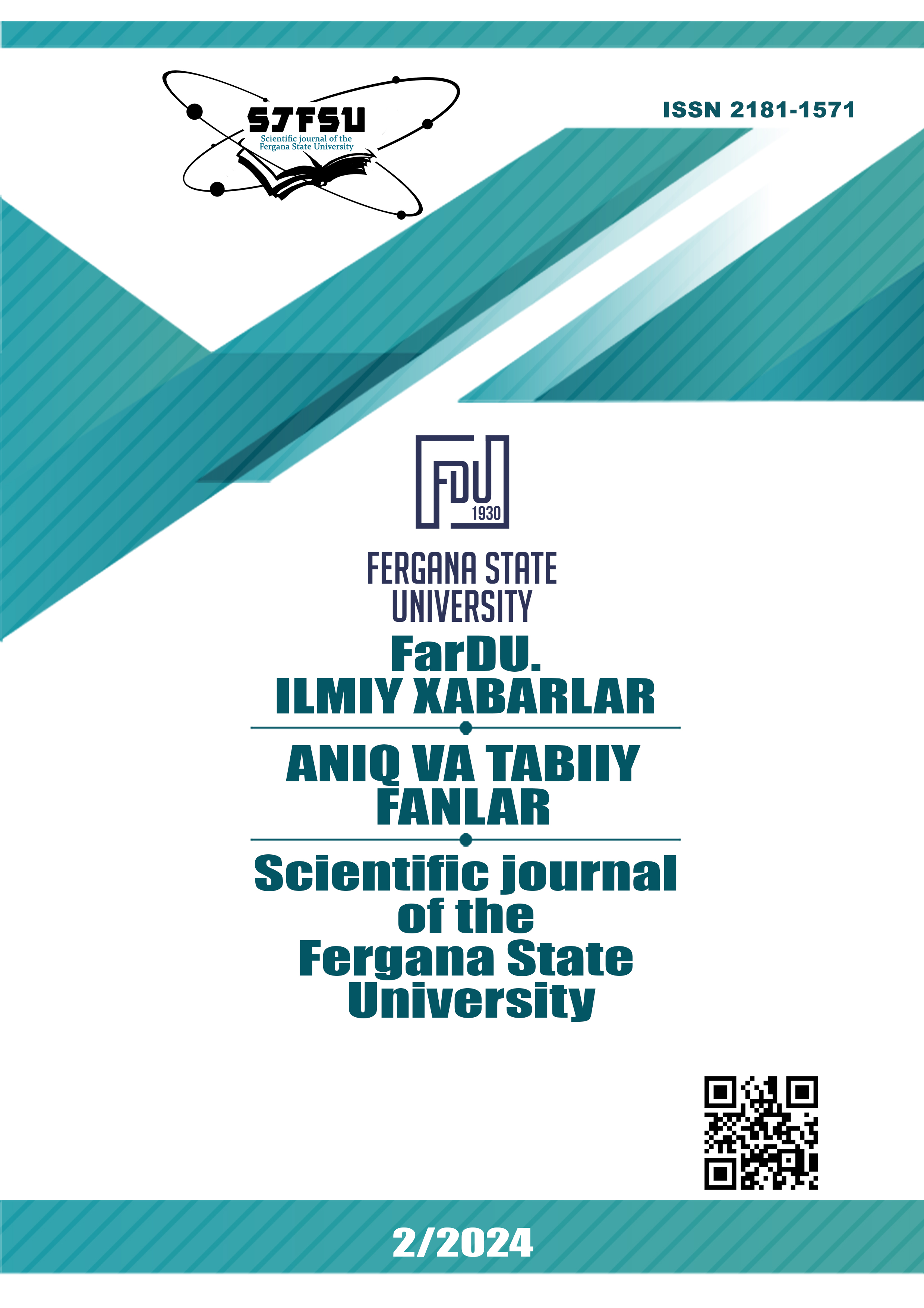ANALYSIS OF MACRO AND MICRO ELEMENTS AND WATER-SOLUBLE VITAMINS OF THE PLANT CYNARA SCOLYMUS L.
Main Article Content
Abstract
The content of macro and micro elements and vitamins in plants is considered one of the important factors that determine their beneficial properties. Humans satisfy the need for macro and micro elements necessary for the body during their life activities, as well as vitamins, mainly by consuming plant products. Naturally in this case it is very important to know which plants store these products in large quantities in their composition. We also analyzed the macro-and micro-element and vitamin composition of the Cynara scolymus L. plant, which is appreciated for a number of its beneficial properties during our study. Studied the composition of water - soluble vitamins, macro-and microelements in the plasma Cynara scolymus L. plant with high-performance liquid chromatography and inductively coupled mass spectrometry, Grows in different regions of the Republic of Uzbekistan. It was found that the amounts of vitamins, macro and microelements in different vegetative parts of Artichoke differ among themselves.
Article Details

This work is licensed under a Creative Commons Attribution-NonCommercial-NoDerivatives 4.0 International License.
References
Speroni E, Cervellati R, Govoni P, Guizzardi S, Renzulli C, Guerra MC. Efficacy of different Cynara scolymus preparations on liver complaints. Journal of ethnopharmacology. 2003 Jun 1;86(2-3):203-11.
Wang M, Simon JE, Aviles IF, He K, Zheng QY, Tadmor Y. Analysis of antioxidative phenolic compounds in artichoke (Cynara scolymus L.). Journal of agricultural and Food Chemistry. 2003 Jan 29;51(3):601-8.
Nateghi R, Samadi F, Ganji F, Zerehdaran S. Hepatoprotective effects of Cynara scolymus L. extract on CCl4 induced liver injury in broiler chickens. International Journal of AgriScience. 2013;3(9):678-88.
Llorach R, Espin JC, Tomas-Barberan FA, Ferreres F. Artichoke (Cynara scolymus L.) byproducts as a potential source of health-promoting antioxidant phenolics. Journal of agricultural and food chemistry. 2002 Jun 5;50(12):3458.
Lattanzio V, Kroon PA, Linsalata V, Cardinali A. Globe artichoke: A functional food and source of nutraceutical ingredients. Journal of functional foods. 2009 Apr 1;1(2):131-44.
Pandino G, Lombardo S, Mauromicale G, Williamson G. Profile of polyphenols and phenolic acids in bracts and receptacles of globe artichoke (Cynara cardunculus var. scolymus) germplasm. Journal of food composition and analysis. 2011 Mar 1;24(2):148-53.
Clifford M, Brown JE. Dietary flavonoids and health-broadening the perspective. Flavonoids: Chemistry, biochemistry and applications. 2006:319.
Brown JE, Rice-Evans CA. Luteolin-rich artichoke extract protects low density lipoprotein from oxidation in vitro. Free radical research. 1998 Jan 1;29(3):247-55.
El Sayed AM, Hussein R, Motaal AA, Fouad MA, Aziz MA, El- Sayed A. Artichoke edible parts are hepatoprotective as commercial leaf preparation. Revista Brasileira de Farmacognosia. 2018 Apr; 28:165-78.
Farag MA, El-Ahmady SH, Elian FS, Wessjohann LA. Metabolomics driven analysis of artichoke leaf and its commercial products via UHPLC–q-TOF-MS and chemometrics. Phytochemistry. 2013 Nov 1;95:177-87.
Khedr AI, Farrag AF, Nasr AM, Swidan SA, Nafie MS, Abdel- Kader MS, Goda MS, Badr JM, Abdelhameed RF. Comparative Estimation of the Cytotoxic Activity of Different Parts of Cynara scolymus L.: Crude Extracts versus Green Synthesized Silver Nanoparticles with Apoptotic Investigation. Pharmaceutics. 2022 Oct 13;14(10):2185.
Sánchez-Rabaneda F, Jauregui O, Lamuela-Raventos RM, Bastida J, Viladomat F, Codina C. Identification of phenolic compounds in artichoke waste by high-performance liquid chromatography–tandem mass spectrometry. Journal of Chromatography A. 2003 Aug 1;1008(1):57-72.
Lattanzio V, van Sumere CF. Changes in phenolic compounds during the development and cold storage of artichoke (Cynara scolymus L.) heads. Food Chemistry. 1987 Jan 1;24(1):37-50.
Shimoda H, Ninomiya K, Nishida N, Yoshino T, Morikawa T, Matsuda H, Yoshikawa M. Anti-hyperlipidemic sesquiterpenes and new sesquiterpene glycosides from the leaves of artichoke (Cynara scolymus L.): structure requirement and mode of action. Bioorganic & medicinal chemistry letters. 2003 Jan 20;13(2):223-8.
Zhu X, Zhang H, Lo R. Phenolic compounds from the leaf extract of artichoke (Cynara scolymus L.) and their antimicrobial activities. Journal of agricultural and food chemistry. 2004 Dec 1;52(24):7272-8.
Shen Q, Dai Z, Lu Y. Rapid determination of caffeoylquinic acid derivatives in Cynara scolymus L. by ultra‐fast liquid chromatography/tandem mass spectrometry based on a fused core C18 column. Journal of separation science. 2010 Oct;33(20):3152-8.
Mejri F, Baati T, Martins A, Selmi S, Serralheiro ML, Falé PL, Rauter A, Casabianca H, Hosni K. Phytochemical analysis and in vitro and in vivo evaluation of biological activities of artichoke (Cynara scolymus L.) floral stems: Towards the valorization of food by-products. Food Chemistry. 2020 Dec 15;333:127506.
Schütz K, Persike M, Carle R, Schieber A. Characterization and quantification of anthocyanins in selected artichoke (Cynara scolymus L.) cultivars by HPLC–DAD–ESI–MS n. Analytical and bioanalytical chemistry. 2006 Apr;384:1511-7.
Romani A, Pinelli P, Cantini C, Cimato A, Heimler D. Characterization of Violetto di Toscana, a typical Italian variety of artichoke (Cynara scolymus L.). Food Chemistry. 2006 Mar 1;95(2):221-5.
Hinou J, Harvala C, Philianos S. Polyphenolic substances of Cynara scolymus L. leaves. InAnnales Pharmaceutiques Francaises 1989 Jan 1 (Vol. 47, No.2, 95-98).

